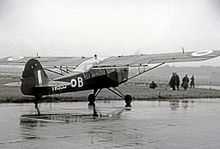Tilstock Airfield
Coordinates: 52°55′52″N 2°39′04″W / 52.931°N 2.651°W Tilstock Airfield is an airfield located in Shropshire, England.
Located close north of the village of Prees, it is 2 miles (3.2 km) east of the village of Tilstock, and 3 miles (4.8 km) south of Whitchurch.
Prees Heath Army Camp
Opened in 1915 as a training base for the British Army, it had a capacity for 30,000 men for training in trench warfare.[1][2] It additionally acted later as a store for supplies, with its own railway depot feed by a 1 mile (1.6 km) branch line from the LNWR's Crewe and Shrewsbury Railway. As casualties mounted, it became a hospital with a fully fledged barracks.
The scale and size of the camp brought about the appointment of the first female police officers in the Shropshire Constabulary, to manage and restrain local women from heading to the camp.[3]
After the war ended, the facilities were downgraded, with the British Government keeping ownership of the site for Army training purposes.
Prees Heath internment camp
At the outbreak of World War II in 1939, the site became an internment camp for screening Austrian and German refugees,[2] with capacity added for holding 2,000 men by the erection of a large tented village.[4] Later converted to a prisoner of war camp, it closed 4 Oct 1941.[5]
RAF Tilstock

Construction of an airfield was completed by mid 1942, the airfield opening on 1 August that year,[6] with a classic three concrete runway RAF "star" arrangement. The name 'Whitchurch Heath' being used until 1 June 1943, when RAF Tilstock was adopted. Between 1 September 1942 and 21 January 1946, the airfield was used by No. 81 Operational Training Unit and No. 1665 Heavy Conversion Unit Royal Air Force for the training of pilots and crews in the operation of Whitley, Stirling and Halifax heavy bombers. During the 1950s, Auster AOP.6 and Auster T.7 'spotter' aircraft of No. 663 (AOP) Squadron RAF used the facilities of the otherwise non-operational airfield during weekends for liaison flights with Royal Artillery units on training exercises.
Sport parachuting
In 1964 it was home to the Manchester Skydivers. In 1967 it became Manchester Free Fall Club (MFFC) run by the ex-para and Club Chief Instructor, Norman Law. Over the next three decades the club was run as a local members club at weekends with a mixture of regular club jumpers and first time jumpers keen to experience sport parachuting and often to raise funds for charity. There were a number of local affiliations with universities and polytechnics with courses being run on a very regular basis. The mainstay aircraft were a number of Cessna 172 and 182s which were initially step exit, moving to the more dignified seat exit. In the 1990s the Club was taken over and run on a more commercial basis, but due to local disputes over noise and some financial difficulties the regularity of flying days declined. It is now Skydive Tilstock Parachute Club which is a non-profit making Sports Club and a Company Limited by Guarantee.[7]
Today
Located near the junction of the A41 and A49, the airfield is still being used today at weekends for skydiving. Skydivers have used the airfield for Tandem Skydiving and running Parachute Jump Courses since 1965. The direction of the remaining runway is 32 (320) and 14 (140).
References
- ↑ "Shropshire timeline". discovershropshire.org.uk. Retrieved 2010-01-08.
- ↑ 2.0 2.1 "Prees Heath". BBC News. Retrieved 2010-01-08.
- ↑ "A Brief History of Whitchurch". NCR 45 Mercian Way. Retrieved 2010-01-08.
- ↑ "A Report on Visits to Internment Camps for Aliens". Virtual Jewish Library. 1940-07-23. Retrieved 2010-01-08.
- ↑ "List of UK Internment Camps". online-archaeology.co.uk. Retrieved 2010-01-08.
- ↑ Smith 1981, p. 193.
- ↑ "Skydive Tilstock Parachute club". Retrieved 12 June 2014.
- Smith, David J. (1981). Action Stations : 3. Military airfields of Wales and the North-West. Cambridge, UK: Patrick Stephens. ISBN 0-85059-485-5.